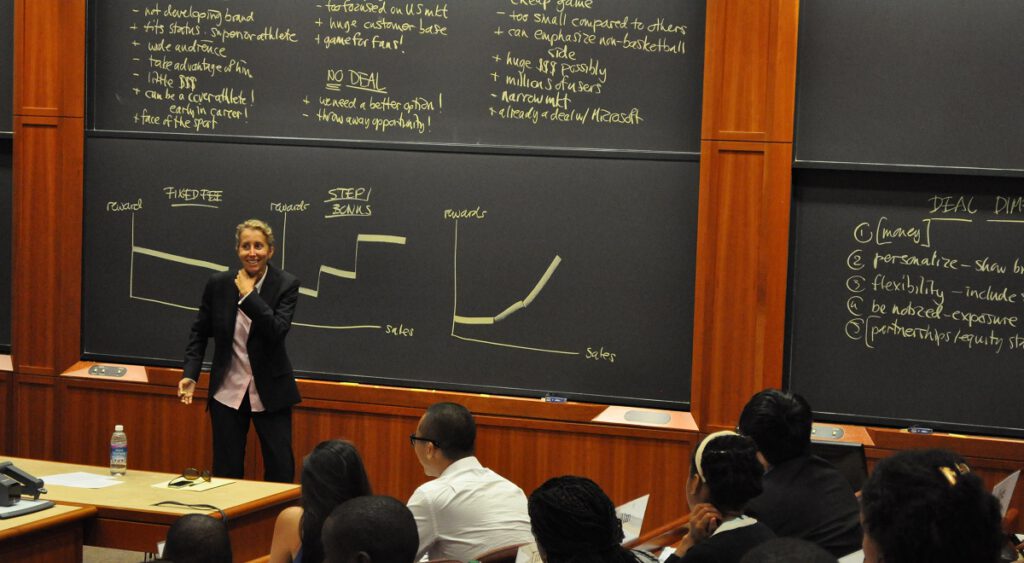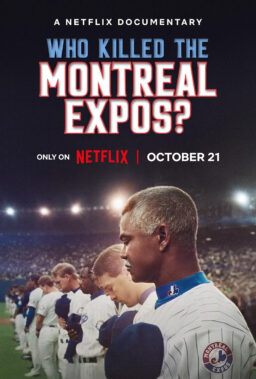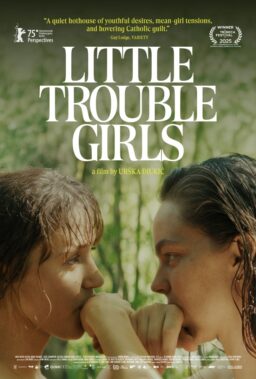Harvard Business School professor Anita Elberse just may have the coolest job on the planet. She’s made a career out of studying and figuring out why the biggest names in film, content publishing, music and sports have been so successful. Names like Warner Bros., Marvel, Jay-Z, Lady Gaga, Tom Cruise, the NFL, Real Madrid, LeBron James—the list goes on.
She details her fascinating research and case-study findings in her book “Blockbusters: Hit-making, Risk-taking, and the Big Business of Entertainment.” Her statistics-driven approach shows that no matter what facet of the entertainment industry you’re talking about—and no matter how contrary to common sense it may seem—those who make the biggest financial investments in a select few products are actually taking the least risky path to success.
Perhaps that’s why 40 (!!!) big-budget superhero movies will be hitting theaters between now and 2020. Or why 1998 was the last year that stand-alone (versus sequel/trilogy/universe) films made up the majority of an annual “top-ten highest-grossing movies” list. In 2011, the entire top twelve were franchise titles.
Now, as Scott Tobias of The Dissolve recently pointed out, it’s not like “blockbuster” always equates to “awful.” But for anyone who still enjoys—or wants to make—an indie or otherwise original film, Elberse’s findings are important to understand.
As the latest summer movie season draws to a close, we checked in with Elberse to discuss some of the most interesting (and, some might say, scary) concepts in “Blockbusters.”
“You can buy an opening weekend.” That’s a film industry saying referenced in your book that could make a critic’s blood run cold. It’s another way of saying, “If you advertise it enough, they will come.” So let’s talk about the whole “self-fulfilling prophecy” idea that huge marketing and advertising blitzes for big-budget movies will almost always guarantee success. Are moviegoers really that easily influenced?
Luckily, it’s all a bit more nuanced! First, the effect is not just about money put toward marketing—it’s about the sum of production and marketing spending. In my research, I’ve found that the film studios and other leading content producers that dedicate a disproportionate amount of their production and advertising budgets to a select group of titles in their portfolio—what I call a “blockbuster strategy”—tend to increase their chances of financial success. That has a number of reasons.
For one, it allows studios to buy the strongest properties and brands and achieve high production values, all of which matter to moviegoers. It also gives studios distinct marketing advantages—it is relatively cost efficient to advertise those bigger properties. But, to speak to your question, there often is a self-fulfilling prophecy at work, too: the sheer act of spending more on a film can sometimes lead to higher revenues.

But how exactly does that self-fulfilling prophecy work?
Production and marketing budgets are important signals to the marketplace. Audiences aren’t the only ones falling for this; everyone in the “value chain” for films takes it as a cue. Theaters, for instance, will often commit to dedicating more screens to big-budget films, and will also give them more favorable weekends. Their decisions can have a huge influence on potential revenues; we know from research that the number of screens given to a film is the single best predictor of its box office success.
Then the media will give these big-budget—or “tent-pole”—films more attention, which drives awareness and the intention to see a film among audiences, and thus also increases likely ticket sales.
Even critics help fuel the self-fulfilling prophecy: no critic has a chance to review all films, but they’ll make sure to cover all the big-budget ones that everyone is talking about, thereby giving the ones that were already drawing attention even more of a push.
I have to make it clear that spending big is no guarantee for success, though. All studios can do by adopting a blockbuster strategy is significantly increase the odds of success. They’ll still have big flops. And great small films can still find a way to large audiences.
Let’s focus on that point for a second. Is there anything else from your research that can give film fans who are already sick of franchise movies some hope?
Thank you for asking this question. A blockbuster strategy is not just about making big bets. Rather, it is about smartly investing in a full portfolio of films. It turns out—this is good news for everyone who wants to see more than just tent-poles—that there is a distinct business need for smaller investments, too.
Smaller films often serve as test cases. Placing less expensive bets can help a studio discover the next big-hit franchise, or the next big bankable actor. Smart studio executives continue to experiment with smaller films to make sure the well of ideas and talent does not dry up.

Right, in your book you mentioned how “The Hangover” (made for $35 million) turned into a franchise that was given the full blockbuster treatment after it surprised everyone and grossed nearly $470 million worldwide.
But even if a smaller bet doesn’t yield the next big hit, those films can help a studio “fill the pipeline,” thereby keeping theaters and other partners who help sell their titles satisfied. Having a larger number of films gives studios the upper hand in negotiations with theaters, resulting in more screens when the studios need them most, and a more favorable revenue-sharing rate.
Having a mix of bigger and smaller titles also helps in forming relationships with agents and financiers, who serve as “gatekeepers” to new opportunities. It also gives studios much-needed flexibility, like being able to move release dates and optimize advertising time already bought from the television networks. It allows them to spread the large fixed costs that come with moviemaking (just think of the expansive lots and offices around the world) over a larger number of titles.
We realize that studios are businesses and need to keep growing profits in order to satisfy shareholders. But does anybody even care if the films are, you know, good?
Having a strong critical reputation still matters greatly to every studio, and smaller projects are more likely to give them a shot at winning industry acclaim and awards. That helps studios attract and retain sought-after A-list talent and their passion projects. And it probably makes everyone at the studio remember why they chose to work in Hollywood in the first place.
What does the implementation of a “blockbuster strategy” by major studios mean for those who make independent or otherwise lower-budget, totally creative films?
I think it’s hard to deny that it creates significant challenges for independent studios and others who seek to produce and market films that are truly original. In an industry in which studios seek to make big bets on the most likely winners, and those titles are picked for having some resemblance to past winners (be it that they are based on a book that was once successful, or star an actor who is seen as bankable, or feature a character that comic-book readers are familiar with), original projects run the risk of being crowded out.

The hard truth is that the average consumer goes to the movies at most once every two months—six times per year—and so studios try to give audiences true spectacles to lure them to the theater and make sure they pick their film over the competition.
Do you have any advice for filmmakers outside of the big studio system?
If you’re an indie producer, I think you need to thoroughly understand the game that the larger studios are playing. Only then can you avoid competing head-to-head. That’s a battle you will surely lose. Instead, you can do one of two things: either seek to differentiate by pursuing the kinds of projects that the larger studios increasingly don’t, or by seeking to partner with those larger studios.
In my book, I describe an indie producer in the music industry, Octone Records, who did just that. They realized that their strength was developing and nurturing artists who didn’t fit the mold of the current music industry, but they also knew that if one of their acts was on the verge of breaking through, there was nothing as crucial as the distribution and marketing power of the larger record labels. So they formed a joint venture with a major label, first SonyBMG and later Universal, and made sure to structure it so it played to each other’s strengths. Those kinds of collaborations are a good model for Hollywood, too.
What about actors and actresses—what does Hollywood’s ever-increasing reliance on blockbuster franchises mean for the cast of those films?
That’s a big, complicated question. I needed two whole chapters to explain that in my book! So I am not sure I can fully do justice to the issue here, but let me outline a few patterns I see happening.
On the one hand, bigger bets tend to go along with higher fees for the talent involved in those bets. We see this across the world of entertainment—markets become ever more concentrated, leading to “winner-take-all” tendencies in which a select few A-listers can earn enormously high fees and a vast group of other, not necessarily less talented performers, can barely make a living.
On the other hand, many of the tent-pole concepts that Hollywood studios are pursuing don’t rely heavily on A-list talent. Their love for franchises involving comic-book characters and other mega-selling properties helps rein in star power, and with it star salaries. “With Harry Potter, the book is the movie star,” Disney Pictures Chairman Alan Horn told me when he was still at Warner Bros. “When you have a film based on a property that everyone knows, you don’t need a big star to sell tickets. You need good actors, but they don’t have to be stars.” The studios have also worked hard to curtail lucrative compensation models for actors, cutting back on back-end deals with actors.

But even in this new world, someone like Robert Downey Jr. can still make $50 million for his role as Tony Stark in the Iron Man and Avengers films. I think we’re in the middle of a big power struggle between content producers and the creative talent they rely on. It’s the same struggle that takes place in a wide range of sectors of the entertainment industry, from publishing to music and television. It’s going to be fascinating to see how this tug-of-war will play out, and what it means for the salaries and the creative freedoms that the biggest superstars enjoy.
We also have to ask you about the subject nearest and dearest to our hearts: film criticism. What roles do and can film critics play when so much money is being thrown into promoting and advertising big-budget films?
There’s an ongoing debate among academics studying the film industry on whether critics are true influencers or merely leading indicators of what audiences end up seeing. I don’t presume to have the answer to that question, but there is certainly an abundance of evidence for the significant role that critics play. There’s a reason why Roger Ebert became a superstar himself! Movies are what marketers call “experience goods,” meaning consumers cannot judge the quality of the product without having consumed it. That makes critics and others who express opinions about movies so instrumental to moviegoers’ decision-making.
I’m biased, of course, but I think it’s actually quite helpful for critics to understand the business side of entertainment. There are big and small things they can do to champion smaller films. Take the self-fulfilling prophecy that we discussed earlier: if you know this phenomenon is real, you also know that as a critic, thinking deeply about how you select the movies you review can help in breaking down that pattern. Merely spending more time or column space on the smaller films may just help elevate their chances of success.
I know Roger Ebert always tried to champion the underdog, and that may be more important now than ever. Critics are probably especially instrumental to movies that are released on a limited number of screens in the hopes that positive word of mouth will propel sales. Here, reaching the right target audiences at the right time is crucial for filmmakers, and critics are often in a very good position to do just that.
You’re an expert on digital media, so we’re curious if you see any change in the distribution strategies of blockbuster films going forward? Some critical darlings like Snowpiercer and Life Itself were released via video on demand (VOD) either while they were still currently in theaters or shortly thereafter. Could this ever happen with big-budget titles?
I don’t think it is on the horizon soon, but I think with the right conditions, it could certainly happen, yes. It all depends on how the VOD window is developing. Also because audiences are already used to shelling out big bucks for, say, boxing matches on pay-per-view channels, I can envision a future in which audiences can see first-run films in their own home before or while they also play in theaters.
If you take all costs for moviegoers into account—the price of a ticket, parking, a babysitter, vast amounts of popcorn—going to the theater can be quite expensive. VOD can be a more convenient and less expensive medium, even if the price per view is higher. Theaters will not welcome such a world, of course, and they will not go down without a fight. But if at some point it makes financial sense for film studios to make the switch to VOD being the first window even for big-budget films, I can imagine they will.
In addition to how films are distributed, where they’re distributed is also changing. We movie fans in the United States are sometimes guilty of assuming everything revolves around our likes and dislikes. How does the global market for movies factor into everything we’ve been discussing?
The international market is hugely important here. The kind of blockbuster bets that the major studios are making play especially well in foreign markets. Tent-pole movies tend to “travel well,” as studio executives say. And the international market is growing rapidly.
Current projections put the foreign box office at $27 billion by 2016, more than twice the domestic box office’s projected $11 billion for that year. Theaters and other exhibitors in international markets will be more selective, if only because they have fewer screens to serve moviegoers.
That’s why they will seek to offer the so-called “four-quadrant movies” that appeal to both young and old and to both male and female. They also want films that feature stars or characters that audiences will know. And that’s exactly what the larger studios increasingly give them. With globalizations come bigger bets on the kinds of franchises that play well overseas.
Thank you so much for sharing your thoughts with us. Before we let you go, are you working on any new research you can give us a hint about?
I’m working on a number of new projects. I continue to be fascinated by people and companies that manage to find sustained success in the entertainment business where hits can be so few and far between. So I’m keen to keep developing case studies in that area, to better understand their secrets.
I’m also very interested in the changing television landscape. It’s amazing to see television increasingly become a haven for serious filmmakers. I think it has everything to do with the intense competition, not just between premium cable channels but also between them and new entrants like Netflix and Amazon. That has led to an influx of money that is invested in great stories and great storytellers.
It must be a thrill for filmmakers and actors to experiment with these new opportunities, get used to the faster pace of television making, and be able to tell a story in twenty or so episodes as opposed to two hours. For me as a researcher, I look forward to examining exactly how television is going to develop, and how that affects the film sector.











